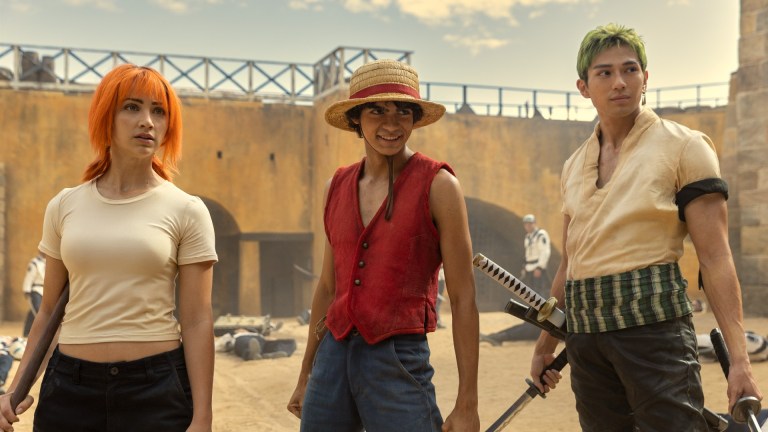Netflix’s One Piece Breaks The Live-Action Anime Curse
Live-action anime adaptations have a long history of disappointing the fandom, but Netflix’s One Piece finds the right balance to break the trend.

This article contains spoilers for Netflix’s One Piece.
Film and television adaptations of stories from other media consistently face uphill battles. Even the most faithful of adaptations can ruffle the feathers of the source material’s die-hard fans or lead audiences to question the point of the adaptation in the first place. Anime and manga have had an even harder time on this front as their live-action adaptations not only have to figure out how to ostensibly bring cartoons to life, but also take into consideration a multitude of sensitive cultural issues.
Audiences are used to writing off live-action anime adaptations after decades of being burnt by projects like Dragon Ball Evolution, Death Note, Ghost in the Shell, Cowboy Bebop, and this year’s Knights of the Zodiac, with live-action versions of Yu Yu Hakusho and My Hero Academia already in development. Even when Japan produces decent live-action anime features like Gintama, Rurouni Kenshin, The Disastrous Life of Saiki K, or any of Takashi Miike’s adaptations (JoJo’s Bizarre Adventure, Ace Attorney, As the Gods Will), they often come across as too insular and made strictly for Japanese audiences and the series’ preexisting fanbases rather than international newcomers.
Even visionary filmmakers like the Wachowskis or Robert Rodriguez struggle to deliver a live-action anime experience that resonates with all audiences in the cases of Speed Racer and Alita: Battle Angel. This is a difficult benchmark to clear and one that often seems as if it sets itself up for failure. However, Netflix’s One Piece charts a fresh course that respects its source material and brings on board the right crew of creatives–including Eiichiro Oda himself–to make sure that this ambitious live-action adaptation confidently swims to success rather than sinking to the bottom of the Grand Line. Here’s how.
An Extremely High Budget & Marketing Push
A high budget is not analogous to a good product. If anything, bloated production budgets and unrealistic box office expectations where one billion dollars is a goalpost, not a cause for celebration, is becoming one of the film industry’s biggest problems. That being said, a live-action One Piece can’t be done cheaply and Netflix doesn’t just understand this, but they’ve been particularly generous on this front. Reports have placed One Piece’s budget at $18 million dollars per episode, which puts the entire eight-episode season at an approximate budget of $144 million. This makes One Piece one of the most expensive series that Netflix has ever produced (behind only Stranger Things), with a higher per-episode budget than Game of Thrones, The Mandalorian, and The Sandman.
This money is very much on the screen and Netflix’s One Piece boasts impressive special effects, costumes, and set design that strive for a higher standard that feels authentic to both the anime and manga panels’ choreography. The action sequences get room to properly breathe and are often presented as lengthy one-take sequences that fully showcase the chaos and personality of these battles rather than hiding this work through quick cuts. These are often the difference between fight sequences that float or sink and it was one of the biggest issues with Cowboy Bebop’s flaccid action sequences. One Piece’s production has been vocal about re-shoots for some of the series’ bigger action sequences in order to better meet Oda’s expectations and not fall short on the series’ more iconic moments.
The central fight between Luffy, Nami, and Zoro against Buggy looks dynamic and genuinely different from any other super-powered showdown in film or television. There’s equal care put into Luffy’s assault against shark-man Arlong and his aquatic crew of miscreants. These fights are unique enough to draw in newcomers, but also encourage them to check out One Piece’s source material to get even more of this universe’s heightened havoc. There are only brief glimpses in this first season of One Piece’s legendary Sea Beasts, but they still trump the grandiose CG creations that have shown up in other reputable fantasy series on Netflix like Wednesday or Jupiter’s Legacy. All of these are instances where One Piece goes for broke and it’s appreciated that the series attempts these tricky feats instead of charting a different course to entirely avoid them.
On top of the money that’s on the screen, Netflix has given One Piece a serious marketing push that trumps their past efforts. Big advertising blitzes have been put together on an international scale that taps into the rabid enthusiasm of the Straw Hat fandom. Netflix has even launched their own anime and manga podcast, MANA, in conjunction with One Piece. The show’s creative team has participated in this new tangent of fandom and positions One Piece as the start of a turning tide in live-action anime and manga productions. Iñaki Godoy, Luffy’s live-action actor, was even on the cover of a recent Weekly Shonen Jump in Japan alongside his manga counterpart. It’s extremely rare that a real person is on a Shonen Jump cover and it’s yet another measure that’s been taken with One Piece that wasn’t taken with Cowboy Bebop or Death Note.
The Creator, Eiichiro Oda, Is Deeply Involved
This team wasn’t the first one that had attempted to do a live-action One Piece. Oda had reservations and caveats, gave intense input, and helped workshop permissible changes rather than them being arbitrarily made by others. Oda was especially precious about the characters’ backstories and Devil Fruit powers not being changed, which it’s easy to see happening if the series were in less respectful hands. Oda also insisted on reshoots to help fix issues rather than settling for anything less than perfection. Matt Owens, the showrunner, has been candid about how Oda was initially quite tough on them and how it took some time to find their rhythm.
There have also been extensive interviews that plug Oda’s involvement and use it as a marketing tool, which has never been done before. The closest equivalent is when Netflix’s Cowboy Bebop got Yoko Kanno to work on the score, but it’s not the same. One Piece’s trailer was even released with a personalized letter from Oda, giving his words as much weight as the show’s actual footage. Not only is this atypical, but it’s the polar extreme of what happened with Netflix’s Cowboy Bebop where Shinichiro Watanabe later lambasted the adaptation for being so off its mark.
The Cast Are True Fans
Casting is a crucial component in any live-action anime adaptation and something that can immediately set a project up for failure in cases like Ghost in the Shell or Dragon Ball Evolution. Any international production of this nature must answer questions regarding the characters’ heritage and its importance. In the case of One Piece, Oda specifically weighed in on how the characters should be portrayed, which has led to a promising diverse cast that avoids past pitfalls like a whitewashed cast or a foreign cast that American audiences won’t know. One Piece finds a crew that should resonate with international audiences.
One Piece finds formidable Straw Hat Pirates in Iñaki Godoy (Luffy), Mackenyu (Roronoa Zoro), Emily Rudd (Nami), Jacob Romero Gibson (Usopp), and Taz Skylar (Sanji). Ian McShane even finds his way into One Piece as its eloquent narrator. Godoy and the rest of the core cast haven’t hidden their passion for Oda’s source material. There have even been Instagram comment exchanges where these actors make deep manga cuts that indicate severe fandom and not just a passing interest or a casual binge through a handful of episodes. It’s hard to not get excited over the cast’s own enthusiasm and how much they care, versus the apathy or ignorance that exists in other live-action anime projects. It’s so easy to root for these actors and hope that the series takes off so that they can keep this dream alive.
Pirate Shows Are In Short Supply
One Piece is far from the first live-action anime adaptation, but it is unique in the sense that it’s the only one about swashbuckling pirates. Audiences’ eyes will glaze over when they see another live-action series about superpowered martial artists or bounty hunters in space. However, a pirate series in general is an exciting rarity that hasn’t worn out its welcome.
There’s a grander scope to One Piece whenever episodes are on water. The extravagant sea creatures and monsters in One Piece make it feel just as much like it’s a Pirates of the Caribbean, Peter Pan, or even a Fifth Element series. This should resonate with audiences whether they have any familiarity with One Piece or not, which is just one less hoop for them to jump through. Yes, One Piece is based on an anime and it never tried to hide this, but it’s also just a fun pirate action series. One Piece even recruits a Black Sails director, Marc Jobst, to helm the first two installments and his pirate and fantasy experience sets One Piece up for success with someone who knows their way around a jib.
One Piece is Supposed To Silly
It’s previously been easy to mock past live-action anime simply because it’s often unnatural to translate a cartoon’s energy to the real world. This becomes an even more impossible task when the material is supposed to be grim or serious. This often results in tonal disasters, like in the cases of Cowboy Bebop, Knights of the Zodiac, Death Note, or Dragon Ball. One Piece tackles some heavier ideas and the series beautifully brings Nami’s tragic tattoo self-harm incident to life without compromise. However, this is a series that’s ultimately supposed to skew younger and embrace the lunacy of over the top super pirates. That energy is easier to sell and make appealing while not coming across as embarrassing or off, like any self-serious anime adaptation.
One Piece Is Too Long To Properly Adapt Anyway
There are series like Cowboy Bebop that only have two-dozen-and-change episodes where it becomes easy for a live-action series to not only match that total, but dwarf it after a few seasons. It’s safe to say that One Piece never has to worry about this with its anime currently at a staggering 1073 episodes and counting. Netflix’s One Piece covers up to the series’ East Blue Saga, which is roughly the anime’s first 60 episodes. This is a sizable chunk for eight episodes that don’t feel rushed, but even a faster pace would require dozens of seasons to properly cover the anime.
By necessity, this is too long and One Piece would be remiss if they didn’t adopt a revised battle plan, albeit with Oda’s input. This opens One Piece up to exciting directions and takes off some of the pressure in a way that’s absent in other anime adaptations. The live-action One Piece doesn’t intend to replace the anime, but merely exist as a loving companion piece that pushes others to seek out the source material. It’s a luxury that most live-action anime lack, but speaks to One Piece’s evergreen status and why it continues to inspire new series, whether they’re manga, anime, or American live-action productions.
All eight episodes of One Piece are available to stream on Netflix now.

